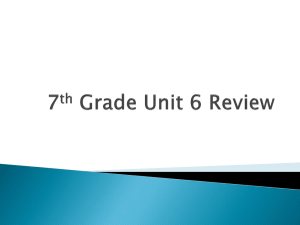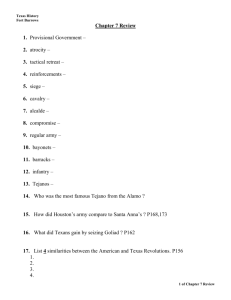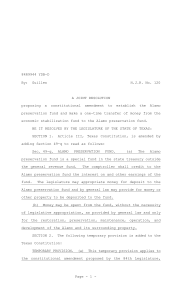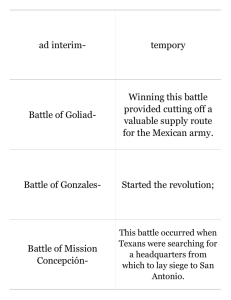How Should We Remember the Alamo? Critical Analyses of Four
advertisement
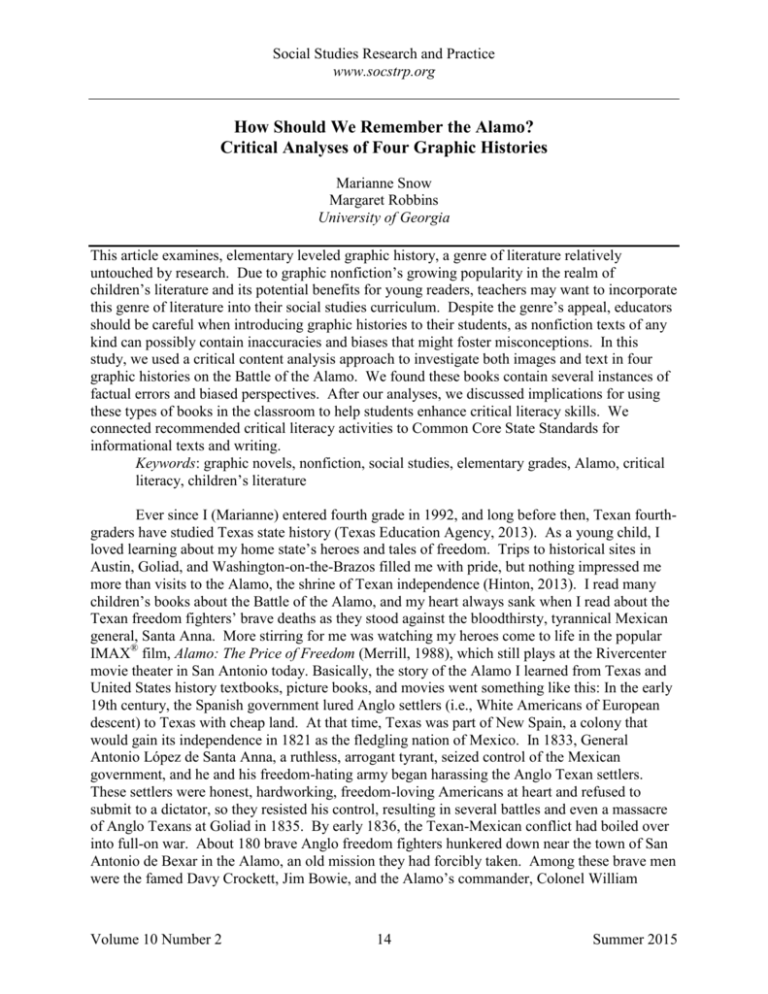
Social Studies Research and Practice www.socstrp.org How Should We Remember the Alamo? Critical Analyses of Four Graphic Histories Marianne Snow Margaret Robbins University of Georgia This article examines, elementary leveled graphic history, a genre of literature relatively untouched by research. Due to graphic nonfiction’s growing popularity in the realm of children’s literature and its potential benefits for young readers, teachers may want to incorporate this genre of literature into their social studies curriculum. Despite the genre’s appeal, educators should be careful when introducing graphic histories to their students, as nonfiction texts of any kind can possibly contain inaccuracies and biases that might foster misconceptions. In this study, we used a critical content analysis approach to investigate both images and text in four graphic histories on the Battle of the Alamo. We found these books contain several instances of factual errors and biased perspectives. After our analyses, we discussed implications for using these types of books in the classroom to help students enhance critical literacy skills. We connected recommended critical literacy activities to Common Core State Standards for informational texts and writing. Keywords: graphic novels, nonfiction, social studies, elementary grades, Alamo, critical literacy, children’s literature Ever since I (Marianne) entered fourth grade in 1992, and long before then, Texan fourthgraders have studied Texas state history (Texas Education Agency, 2013). As a young child, I loved learning about my home state’s heroes and tales of freedom. Trips to historical sites in Austin, Goliad, and Washington-on-the-Brazos filled me with pride, but nothing impressed me more than visits to the Alamo, the shrine of Texan independence (Hinton, 2013). I read many children’s books about the Battle of the Alamo, and my heart always sank when I read about the Texan freedom fighters’ brave deaths as they stood against the bloodthirsty, tyrannical Mexican general, Santa Anna. More stirring for me was watching my heroes come to life in the popular IMAX® film, Alamo: The Price of Freedom (Merrill, 1988), which still plays at the Rivercenter movie theater in San Antonio today. Basically, the story of the Alamo I learned from Texas and United States history textbooks, picture books, and movies went something like this: In the early 19th century, the Spanish government lured Anglo settlers (i.e., White Americans of European descent) to Texas with cheap land. At that time, Texas was part of New Spain, a colony that would gain its independence in 1821 as the fledgling nation of Mexico. In 1833, General Antonio López de Santa Anna, a ruthless, arrogant tyrant, seized control of the Mexican government, and he and his freedom-hating army began harassing the Anglo Texan settlers. These settlers were honest, hardworking, freedom-loving Americans at heart and refused to submit to a dictator, so they resisted his control, resulting in several battles and even a massacre of Anglo Texans at Goliad in 1835. By early 1836, the Texan-Mexican conflict had boiled over into full-on war. About 180 brave Anglo freedom fighters hunkered down near the town of San Antonio de Bexar in the Alamo, an old mission they had forcibly taken. Among these brave men were the famed Davy Crockett, Jim Bowie, and the Alamo’s commander, Colonel William Volume 10 Number 2 14 Summer 2015 Social Studies Research and Practice www.socstrp.org Barret Travis, as well as women, children, and Colonel Travis’ slave, Joe. Furious about the Texans’ rebellion, General Santa Anna vowed he would take back the mission so, in late February of 1836, he and his army attacked it. Colonel Travis knew fighting back would mean certain death for everyone, so he gathered the defenders in the Alamo’s courtyard, drew a line in the sand with his sword, and told the men that anyone who cared about freedom should cross the line and pay the ultimate price. Every man except for one coward crossed. The Texan defenders then held the Alamo bravely, but after a few days, all of these heroes died fighting. After the battle, Davy Crockett’s body was found surrounded by at least a dozen dead Mexican soldiers as he had taken down as many enemies as he could before succumbing. Having been viciously murdered in the name of liberty, the Alamo defenders became martyrs of the Texas Revolution and inspired their Anglo brethren to defeat Santa Anna and win their freedom on April 21, 1836 at the Battle of San Jacinto. I cherished this noble tale from Texan and American history. The only problem is this tale is not completely accurate. As I have learned more about Texas history, I have come to understand much of what I absorbed as a child was a mixture of fact, myth, and bias. The truth, for example, is Colonel Travis most likely never drew that line in the sand (Hinton, 2013; Nofi, 1992), nor did some of the Alamo defenders die during the battle. A few men, possibly including Davy Crockett, survived and were then captured and executed once the fighting stopped (Groneman, 1999; Tucker, 2011). Many of Alamo defenders, moreover, were Tejanos (people of Mexican ancestry living in Texas), so the Texas Revolution wasn’t a clear-cut ethnic conflict between Anglos and Mexicans (Schoelwer, 1985; Tyler, Barnett, Barkley, Anderson, & Odintz, 1996). Other historical inaccuracies may seem less vital to the story but still reflect the errors I learned. Anglo Texans, for instance, actually referred to themselves as Texians (Hardin, 2010), and many historians now agree there were over 250 men, not 180, fighting with Colonel Travis (Hardin, 2010; Tyler et al., 1996). Next, comes the issue of perspective. The image of the Alamo fighters I developed was one of perfection. These men were heroes or martyrs for the sacred cause of freedom; however, William Barret Travis, Jim Bowie, and Davy Crockett were actually complicated human beings with both strengths and flaws (Davis, 1998), so why was I not privy to that perspective? The Alamo story I learned was solely from the Anglo Texian point of view. Why was I not exposed to any accounts of the battle from the Tejano or Mexican perspectives? What about the perspectives of the free and enslaved Black Texans from that time (Barr, 1996; Lack, 1985)? I certainly do not recall ever learning about their experiences and points of view. As a lover of history, confronting my flawed, one-sided vision of the Alamo was a jarring ordeal that led us to investigate bias in social studies learning materials and curricula. Many studies have shown history textbooks used in schools in the United States contain biases and stereotypes (Cruz, 2002; Loewen, 2008, 2013; Moreau, 2003; Romanowski, 1996). Exploring this research then caused us to wonder whether recent nonfiction children’s literature about the Alamo contains errors and bias. Do newer books on this topic present multiple perspectives about the battle, or do they still valorize the White Texian point of view? These questions are a timely concern. Students across the United States learn about the Alamo and the Texas Revolution as they study the country’s westward expansion during the 19th century (e.g., California Department of Education, 2009; Georgia Department of Education, 2013; Virginia Department of Education, 2008). The Common Core State Standards, which have been formally Volume 10 Number 2 15 Summer 2015 Social Studies Research and Practice www.socstrp.org adopted by 43 states and the District of Columbia, stress the importance of reading informational texts as part of the elementary grades’ social studies and language arts curricula (Common Core State Standard Initiative, 2015a). Elementary students around the United States, therefore, are very likely to encounter nonfiction texts about the Alamo. We are interested in nonfiction graphic literature (e.g., texts created in a comic book style), as it is a literary format currently popular with students of all ages (Hughes-Hassell & Rodge, 2007) and is gaining more acceptance as a valuable learning material in schools (Chase, Son, & Steiner, 2014). Due to graphic literature’s growing popularity, the study of the Alamo and the Texas Revolution in elementary schools across the country, and the Common Core State Standards’ emphasis on informational texts, we argue the importance of critically examining the types of information students are gleaning from these books. We also examine the value of teaching children in the primary grades to critically analyze history. Few studies have focused on graphic literature about historical topics, and those have concentrated primarily on students in middle and high school (Clark, 2013; Cromer & Clark, 2007; Frey & Noys, 2002; Mathews, 2011; Werner, 2002). We have been unable to find any research analyzing the content of graphic histories intended for elementary students. The purpose of this study, therefore, was to critically analyze the content of four primary-level graphic histories on the Alamo and to provide suggestions for introducing these books in elementary school classrooms. Graphic Literature Teachers, generally speaking, have traditionally favored fiction texts over nonfiction texts in all elementary subject areas (Duke, 2000; Venezky, 2000; Williams, 2009), which can prevent children from experiencing the many benefits of reading nonfiction texts. First, reading a variety of texts, including nonfiction, can foster children’s overall literacy development (Duke, BennettArmistead, & Roberts, 2003; Jones, Gorman, & Suellentrop, 2004). Exposure to information on historical and other factual topics can also encourage students’ enthusiasm for learning, as “the real world has something for everyone” (Harvey, 2002, p. 22). Reading and writing about realworld subjects, moreover, can improve children’s vocabulary and writing skills (Dreher, 2003; Ray, 2004). In order for elementary-aged children to benefit from reading nonfiction texts, the texts need to be available and accessible in schools, meaning teachers must know how to effectively select and implement nonfiction in the classroom (Palmer & Stewart, 2003). When searching for quality narrative nonfiction texts, such as books about historical events, teachers should seek “well-written and well-illustrated” (Kristo & Bamford, 2004, p. 12) stories with a clear beginning, middle, and end (Williams, 2009). The authenticity of the books’ content should be considered, to ensure information presented in these texts is accurate and void of stereotypes about people and events (Bauml & Field, 2012). Graphic literature can be an excellent source for nonfiction reading in the primary grades. Unlike comics, which are more “ephemeral” and “light and humorous,” graphic literature tends to deal with more serious topics and factual information (Cromer & Clark, 2007, p. 577). Graphic nonfiction books can help ignite children’s enthusiasm for history due to their combination of adventure, drama, and educational value, so providing students with history texts in a popular, appealing format can pique their interest and help them enjoy learning about the past (Christensen, 2006; Chute, 2008). In recent years, publishers have increased their Volume 10 Number 2 16 Summer 2015 Social Studies Research and Practice www.socstrp.org production of graphic literature for elementary-aged children, making it easier for teachers to find these types of books for their students (Brenner, 2010; Chase et al., 2014). As mentioned previously, many nonfiction books include stereotypes and incorrect information, so educators must remain aware of these concerns. Teachers, however, can still use potentially problematic texts to help their students to not only understand any piece of writing can contain biases and inaccuracies but to also know how to respond to these issues (Avila & Moore, 2012; Mission & Morgan, 2006). Social studies classes are particularly promising places to teach children to be critical consumers of information, since part of learning about history is understanding not all primary and secondary sources are reliable (Epstein, 2009; Heffernan & Lewison, 2009; Mathews, 2011; Soares & Wood, 2010; Wineburg & Martin, 2004). Research Design When planning our analysis of graphic histories about the Battle of the Alamo, we knew we wanted to question Anglo perspectives on Texas history and privilege marginalized populations’, in this case, the Mexicans’ and Tejanos’ points of view. We found Latino/a critical theory to be a helpful framework, since this theory calls for scrutinizing racism directed at Latino/a people and championing social justice (Delgado Bernal, 2002). Building upon this theory also allowed us to challenge Anglo historical epistemologies, or ways of knowing history, and to listen to marginalized voices and detect possible “counter-stories” (Solórzano & Yosso, 2002, p. 32) in the historical texts we analyzed (Yosso, Villalpando, Delgado Bernal, & Solórzano, 2001). To put Latino/a critical theory into action, we evaluated the Alamo books using a critical literacy approach (Lewison, Flint, & Van Sluys, 2002). Beneficial not only to scholars, but also to teachers, students, and other readers, critical literacy involves: • Employing a critical perspective to consider various perspectives and viewpoints present in a text, recognize perspectives that are minimized or omitted, and uncover stereotypes; • Investigating power relationships between or among people or groups depicted in a text; • Taking action to confront any unsubstantiated assumptions, stereotypes, or biases portrayed in a text. Readers can follow these guidelines when analyzing illustrations in books in order to practice their critical visual literacy skills. A reader, for example, might critically question the use of color in an image and the presence or absence of people or objects in illustrations (Callow, 2008; Maney, 2005; Schieble, 2014). In this study, we used these guidelines to analyze four elementary-level graphic histories on the Alamo. The following questions shaped our analysis: 1. How historically accurate are these books? 2. How do the books include or exclude multiple perspectives on the Battle of the Alamo? After presenting our evaluation of the graphic histories in question, we explain how teachers can take advantage of this critical reading process when using these books in their classrooms. Data Collection As we began searching for books to include in this study, we developed a list of criteria to focus our selection process. First, the texts on the Alamo had to be nonfiction. Second, books had to be intended for the later elementary (3rd through 5th) grades. Finally, books had to Volume 10 Number 2 17 Summer 2015 Social Studies Research and Practice www.socstrp.org be published 2005 or later. This search resulted in a sample of 28 books. While sifting through these texts, we discovered four were graphic histories, and given the popularity and potential benefits of graphic literature for teaching and learning about history (Christensen, 2006; Chute, 2008) as well as the lack of research on graphic nonfiction for younger children, we decided to concentrate on these books (Table 1). Table 1 Alamo Graphic Histories Publication Date Title Author 2005 The Battle of the Alamo Matt Doeden 2006 The Battle of the Alamo Kerri O’Hern & Janet Riechecky 2008 The Battle of the Alamo Rod Espinosa 2012 The Battle of the Alamo Gary Jeffrey As above indicated, we followed critical textual and visual analysis guidelines when examining these books (Callow, 2008; Lewison et al., 2002; Maney, 2005; Schieble, 2014). Since print and images work so closely together in graphic literature (Schwarz, 2002), we considered the written text and the illustrations simultaneously when questioning each work for its historical accuracy and its inclusion or exclusion of multiple perspectives about the Alamo. We asked whether the authors of the books presented as facts well-known legends and uncertainties, such as: William Barret Travis’ line in the sand, Davy Crockett’s death during battle, and the number of Alamo defenders. We also noted other miscellaneous visual or textual historical inaccuracies. The authors’ and illustrators’ portrayals of the participants in the battle were investigated. Questions included: How are Anglo Texians, Mexicans, Tejanos, and Black Texians depicted in these books? Do members of these various groups present their perspectives in the texts, or do the books’ creators focus solely on the White Texian point of view? Are Mexican figures demonized or stereotyped? With these themes in mind, we began reading the texts and coding them accordingly. Whenever we found an example of historical inaccuracy in one of the books, we labeled the passage in question as inaccurate and recorded its content and location. We noted the presence, descriptions, and dialog of non-Anglo historical figures in the books in order to determine whether the authors of the texts included information about or perspectives of Tejanos, Mexicans, or Black Texians involved in the Battle of the Alamo. In the following sections, we present examples of our findings for each of these themes. Historical Accuracy When investigating our research questions, we found problematic elements in each of the texts in the sample. In describing our findings, we present the texts in the order in which we analyzed them, starting with Matt Doeden’s (2005) The Battle of the Alamo. The discussion moves to Kerri O’Hern and Janet Riehecky’s (2006) text, which is followed by Gary Jeffrey’s (2012) version, and concludes with Rod Espinosa’s (2008) text. Doeden Doeden is the most successful of all the authors in separating myth and uncertainty from fact. He, for example, acknowledges the line in the sand story is a legend (p. 15). He admits no historians know precisely how Davy Crockett died (p. 25) or the exact number of Alamo Volume 10 Number 2 18 Summer 2015 Social Studies Research and Practice www.socstrp.org defenders (p. 28). The illustrations, though, are the main source of inaccuracy. One error involves the drawings of Mexican army uniforms, which in this book, consist of red jackets and blue trousers. At the time of the Texas Revolution, however, General Santa Anna and most of his soldiers wore dark blue jackets with varying amounts of red trim; only some soldiers wore red jackets (Chartrand, 2004; Haythornthwaite, 1992). It is unclear why the illustrators chose red for the Mexicans soldiers’ uniforms, but we posit they wanted to associate the Mexican army with danger, or perhaps they wished to allude to another famous enemy in American military history, the British Redcoats. This possible artistic license, however, may be confusing to young readers if they have seen more accurate depictions of Mexican army uniforms elsewhere. Another error in the artwork is the portrayal of Alamo combatants’ skin tones. When creating human figures in this book, the illustrators chose to give all of the Mexican soldiers, including General Santa Anna, the same brown skin tone, while all of the Alamo defenders have pale skin. This choice neglects the reality of the combatants’ ethnicities, which, as previously stated, were diverse. Many were Anglos of European descent, but others were of Mexican or African descent. Santa Anna’s ancestry, meanwhile, was probably completely European (Fowler, 2007), and the soldiers under his command were of indigenous, African, European, and mixed ethnic backgrounds (Crisp, 2004). Due to this diversity, the combatants on both sides of the battle would have had varying skin tones and physical appearances. By imbuing Mexican soldiers with uniformly dark skin and Alamo defenders with uniformly light skin, the illustrators run the risk of incorrectly teaching readers the battle was fought along color lines (Crisp, 2004) and possibly leading children to associate light skin with heroes and dark skin with enemies. O’Hern and Riehecky The second book in the sample by O’Hern and Riehecky presents a mixture of truth and error. While the authors exclude the myth of the line in the sand and acknowledge there were “nearly 300” people in the Alamo (p. 21), they perpetuate the legend of Davy Crockett’s death by showing Mexican soldiers gunning him down during the battle (p. 29). The text also incorrectly labels the Texians as Texans. Illustrations contain several inaccuracies, particularly in visual representations of flags. The drawing of the Spanish and Mexican flags (p. 7), for example, shows the countries’ modern flags rather than the designs in use at the time (Smithsonian, 2014; University of Texas, 2014). The illustrators, further, include a drawing of the Lone Star flag (p. 13), which was not adopted until 1839, three years after the Battle of the Alamo (Spain, 1992). Jeffrey and Espinosa Like O’Hern and Riehecky’s version, Jeffrey’s book omits the line in the sand myth but depicts Davy Crockett dying in battle and refers to the Alamo defenders as Texans rather than Texians. Espinosa’s book does the opposite. He portrays the line in the sand as a factual event but correctly uses the term Texians and acknowledges Crockett’s execution after the battle. In sum, all of the books in our sample contained significant historical inaccuracies, such as unrealistic representations of people and objects in the illustrations and the propagation of myths and incorrect terminology in the written text. Although the errors in these texts may seem to be minor details, they can potentially give children wrong ideas about the historical context of the Texas Revolution. This misrepresentation of the historical context might then lead readers to develop a problematic conceptualization of this period, especially concerning political and ethnic relations among the different cultural groups in 1830s Texas. Recognizing these inaccuracies, therefore, is crucial should teachers consider using these books to teach history. Volume 10 Number 2 19 Summer 2015 Social Studies Research and Practice www.socstrp.org Perspective After analyzing the accuracy of the graphic histories, we examined the illustrations and written text in each book to determine the ways that the authors and illustrators depicted the actors in the battle and their points of view. In order to investigate issues of perspective, we: recorded and analyzed who was present in the texts, studied how the narrator of each text describes various historical figures, and investigated how the characters present their points of view. Doeden Doeden portrays Anglos and Mexicans omitting any reference to other ethnicities in the main body of the text, only briefly commenting on Tejanos in an endnote (p. 28). He overwhelmingly uses positive language to define the Texians while reserving negative phrases for the Mexicans. He explains, for example, how the Texians “fight hard for freedom” (p. 8), constantly shout, “No surrender!” (pp. 17, 20, 22, 25), and hold fast to the famous American phrase “Liberty or death!” (p. 20). On the other hand, Doeden describes Santa Anna as a “ruthless” man who “want[s] ideas of freedom out of Texas” (p. 4). This focus on the Texians as positive characters and Mexicans as negative characters shows readers that they should valorize the Anglo perspective in these books while devaluing the Mexican point of view. Meanwhile, Doeden also controls the perspectives presented in his book through his use of dialog. Throughout the text, mostly famous figures (Travis, Crockett, and Santa Anna) do the speaking and sharing of ideas and opinions. While he gives small amounts of dialog to regular Mexican soldiers, the content of their speech consists merely of awed comments about Crockett’s shooting skills and their acceptance of Santa Anna’s orders. Readers only encounter the opinions of highranking, famous Alamo combatants, preventing them from hearing what many ordinary Texians and Mexicans potentially thought about the battle. O’Hern and Riehecky Like Doeden, O’Hern and Riehecky neglect to include information about the Tejano and Black Texian presence in the Alamo. The only combatants portrayed in this text are Anglo Texians and Mexicans. These co-authors also use positive language to describe the Anglos while incorporating negative adjectives in their descriptions of Santa Anna. While the Texians are a “symbol of courage […] against all odds” (p. 30), the Mexican general is “furious” (p. 12) and “angry” (p. 16). O’Hern and Riehecky differ from Doeden in their use of dialog. Instead of letting characters share their opinions, they rely mostly on third-person narration and hardly include any dialog, limiting characters’ speech to orders and commands during the battle. We are unable to learn more about what different figures felt and thought about the conflict due to the dearth of dialog. Due to these choices, O’Hern and Riehecky construct a biased text that encourages readers to support the Texian cause while vilifying the Mexican side and to remain unaware of other cultural presences at the battle. Jeffrey Jeffrey also focuses simply on Anglo Texians and Mexicans while leaving out any mention of Tejanos and Black Texians involved in the battle. When explaining the details of the battle, he uses affirmative descriptors for the Texians, calling them “legendary” (p. 16) and “stunning” (p. 22), whereas Santa Anna is “ruthless” (p. 22), and the Mexican soldiers are “sick with battle fever” (p. 17). In addition to this biased language, Jeffrey makes another choice of only presenting the perspectives of famous, high-ranking characters through dialog and silencing Volume 10 Number 2 20 Summer 2015 Social Studies Research and Practice www.socstrp.org ordinary combatants. By portraying the Texians and Mexicans in these ways, Jeffrey urges readers to identify with the heroes, the Texians, and adopt their points of view. Espinosa Diverging from the other authors’ patterns, Espinosa acknowledges the presence of Tejanos and William Barret Travis’ slave, Joe, in the Alamo, although he only mentions these figures in passing. Espinosa also recognizes the diversity present in the Mexican army, which included “Mayan Indians who could not speak Spanish” and European and mixed ethnic ancestry soldiers (p. 8). Espinosa gives dialog not only to Texian and Mexican figures, but also briefly to a Tejano family and two Tejana women caring for the ailing Jim Bowie in the Alamo. These brief facts and minimal dialog are the only attention Espinosa pays to the diversity of the Alamo defenders and Mexican troops; otherwise, the focus of the text is on Anglo figures. In his descriptions of the Texian and Mexican characters, Espinosa returns to the pattern set by the other authors. Whereas the Texians are “rugged” (p. 5), full of “determination” (p. 20), and “fierce” (p. 24), Santa Anna—the only Mexican character described—is “impatient” (pp. 21, 26) and an instigator of “unnecessary” violence (p. 26). Though Espinosa overall acknowledges the diversity of the Alamo combatants, he fails to break away completely from the typical privileging of Anglos over other ethnicities. To summarize, most of the authors include majority Texian and a few Mexican characters and voices in their texts. Only in Espinosa’s book do readers see or hear anything substantive from members of a different group. The main presence, descriptions, and perspectives readers encounter in all of the texts, however, are those of the Alamo defenders: who want freedom, that of Santa Anna: who wants to defeat the Texians. None of the texts present the actual opinions of Tejanos, Black Texians, Mexican soldiers, or women about the battle. By overlooking and silencing these people, the authors strip their power, and readers are unable to empathize with them or even recognize their points of view. Implications After analyzing these four graphic histories about the Alamo, we found each book contained historical inaccuracies and mainly presented Anglo perspectives about the conflict, thereby privileging Anglos above historical figures of Tejano, Mexican, or Black Texian backgrounds. By considering these issues, we followed the first three guidelines for critical textual and visual analysis (Callow, 2008; Lewison et al., 2002; Maney, 2005; Schieble, 2014): (1) questioning assumptions and stereotypes in texts, (2) discovering different perspectives in texts, and (3) investigating power relationships amongst actors in texts. As for the fourth step, taking action, we confronted the problematic elements of these books by sharing our findings. Teachers and students do not have to passively accept the inaccuracies and biases in these books. They can follow the same steps to engage in critical thinking when exploring graphic histories or any nonfiction text. Our analysis demonstrates the need for teachers to take the time to read nonfiction books before introducing them in their classrooms. The books in this study contain errors and a narrowness of perspective that need to be deliberated with students so they do not absorb incorrect information and bias. Teachers do not need to avoid books or censor containing historical inaccuracy or lack of multiple perspectives. They, instead, can read historically accurate books with their students, then compare the accurate books with these graphic histories and engage in critical discussions spurred by age-appropriate questions, such as: Volume 10 Number 2 21 Summer 2015 Social Studies Research and Practice www.socstrp.org Do you think it is okay the authors and illustrators presented incorrect information in these books? Why or why not? Whose stories do these books tell? Whose stories are omitted? Do you think it is fair that some people’s stories were left out? Why or why not? Are there any historical figures from the Alamo (famous or not famous) you’d like to know more about? What roles did Tejanos, Black Texians, women, ordinary Mexican soldiers, and civilians play at the Battle of the Alamo, and why do you think the authors left their stories out? After discussing these questions and sharing their ideas, students can work together to formulate plans for taking action and confronting any injustices and inequities they have uncovered in the books. If they have trouble generating their own ideas for action, teachers can suggest ideas, such as writing to the books’ publishers to request more accurate and less biased books. Students might work also with school librarians to find, fundraise, and purchase more accurate nonfiction texts about the Alamo. Books to consider include: Sherry Garland’s (2000) Voices of the Alamo, a collection of poetry narrated by the various historical figures who lived on the lands where the Alamo stands; Amie Jane Leavitt’s (2008) The Battle of the Alamo, a choose-yourown-adventure book that presents the perspectives of multiple Mexican and Texian combatants; and Susan Taylor Brown’s (2011) Enrique Esparza and The Battle of the Alamo, a reader’s theater book that depicts the experiences and views of Enrique Esparza, son of one of the Tejano Alamo defenders and survivor of the siege. Though these books portray historical accuracy and multiple perspectives more successfully than the books in our above sample, they are not graphic histories. Students, therefore, can create their own graphic accounts of the Alamo by consulting and evaluating a variety of primary and secondary sources about the battle. They then can work through drafts of their graphic histories, and publish their final products by sharing them with classmates or by placing them in the school library. This type of activity is especially beneficial, since it encourages students to synthesize their creativity, writing and critical thinking skills, and the historical information they have learned. In addition to helping students develop their critical literacy skills, these types of activities meet several of the Common Core literacy standards for the later elementary grades (Common Core State Standards Initiative, 2014). Reading, comparing, and evaluating multiple informational texts, such as graphic histories or less biased texts about the Battle of the Alamo encourages students to (Common Core State Standards Initiative, 2015b-d): identify the main ideas of these nonfiction texts (ELA-Literacy.R1.3.2, 4.2, 5.2); differentiate their own perspectives from the authors’ (ELA-Literacy.R1.3.6); examine and evaluate two or more accounts of the same event (ELALiteracy.R1.5.6); and compare/contrast key points and synthesize information from more than one text (ELA-Literacy.R1.3.9, 4.9, 5.9). Meanwhile, creating their own graphic histories allows students to (Common Core State Standards Initiative, 2015e-g): undertake their own research projects (ELA-Literacy.W.3.7, 4.7, 5.7); write their own informational texts (ELA-Literacy.W.3.2, 4.2, 5.2); Volume 10 Number 2 22 Summer 2015 Social Studies Research and Practice www.socstrp.org and draft, revise, and publish their work (ELA-Literacy.W.3.4-5, 4.4-5, 5.4-5). Teachers and students must understand, although graphic histories are popular resources that can foster children’s learning, they should be critiqued. Being vigilant about these texts’ contents can provide children with rich, valuable learning experiences to help them become more critical consumers of the information that surrounds them. By engaging students in critical readings of graphic histories and other historical texts and encouraging them to brainstorm and implement creative approaches to confronting bias, educators can help children build their academic skills while dismantling the stereotypes so pervasive in our nation’s historical discourse. References Avila, J., & Moore, M. (2012). Critical literacy, digital literacies, and Common Core State Standards: A workable union? Theory into Practice, 51(1), 27-33. Barr, A. (1996). Black Texans: A history of African Americans in Texas, 1528-1995. Norman, OK: University of Oklahoma Press. Bauml, M., & Field, S. L. (2012). Celebrating another decade of primary grade notable social studies trade books. Social Studies Research and Practice, 7(2), 15-32. Brenner, R. (2010). Comics and graphic novels. In S.A. Wolf, K. Coats, P. Enciso, & C. Jenkins (Eds.), Handbook of research on children’s and young adult literature (pp. 255-267). London, UK: Routledge. Brown, S. T. (2011). Enrique Esparza and the Battle of the Alamo. Minneapolis, MN: Millbrook Press. Callow, J. (2008). Show me: Principles for assessing students’ visual literacy. The Reading Teacher, 61(8), 616-626. Chartrand, R. (2004). Santa Anna’s Mexican army 1821-48. New York, NY: Osprey. Chase, M., Son, E. H., & Steiner, S. (2014). Sequencing and graphic novels with primary-grade students. The Reading Teacher, 67(6), 435-443. Christensen, L. L. (2006). Graphic global conflicts: Graphic novels in the high school social studies classroom. The Social Studies, 97(6), 227-230. Chute, H. (2008). Comics as literature? Reading graphic narrative. PMLA, 123(2), 452-465. Clark, J. S. (2013). “Your credibility could be shot”: Preservice teachers’ thinking about nonfiction graphic novels, curriculum decision making, and professional acceptance. The Social Studies, 104, 38-45. Crisp, J. E. (2004). Sleuthing the Alamo: Davy Crockett’s last stand and other mysteries of the Texas Revolution. New York, NY: Oxford University Press. Cromer, M., & Clark, P. (2007). Getting graphic with the past: Graphic novels and the teaching of history. Theory and Research in Social Education, 35(4), 574-591. Cruz, B. C. (2002). Don Juan and rebels under palm trees: Depictions of Latin Americans in US history textbooks. Critique of Anthropology, 22(3), 323-341. Davis, W. C. (1998). Three roads to the Alamo: The lives and fortunes of David Crockett, James Bowie, and William Barret Travis. New York, NY: Harper Collins. Delgado Bernal, D. (2002). Critical race theory, Latino critical theory, and critical race-gendered epistemologies: Recognizing students of color as holders and creators of knowledge. Qualitative Inquiry, 8(1), 105-126. Doeden, M. (2005). The Battle of the Alamo. Mankato, MN: Capstone Press. Volume 10 Number 2 23 Summer 2015 Social Studies Research and Practice www.socstrp.org Dreher, M. J. (2003). Motivating struggling readers by tapping the potential of information books. Reading & Writing Quarterly, 19, 25-38. Duke, N. (2000). 3.6 minutes per day: The scarcity of informational texts in first grade. Reading Research Quarterly, 35, 202-224. Duke, N., Bennett-Armistead, V. S., & Roberts, E. M. (2003). Filling the great void: Why we should bring nonfiction into the early-grade classroom. American Educator, 27(1), 30. Epstein, T. (2009). Interpreting national history: Race, identity, and pedagogy in classrooms and communities. New York, NY: Routledge. Espinosa, R. (2008). The Battle of the Alamo. Edina, MN: ABDO Publishing Group. Fowler, W. (2007). Santa Anna of Mexico. Lincoln, NE: University of Nebraska Press. Frey, H., & Noys, B. (2002). Editorial: History in the graphic novel. Rethinking History, 6(3), 255-260. Garland, S. (2000). Voices of the Alamo. New York, NY: Scholastic. Groneman, B. (1999). Death of a legend: The myth and mystery surrounding the death of Davy Crockett. Plano, TX: Republic of Texas Press. Hardin, S. L. (2010). Texian Iliad: A military history of the Texas Revolution, 1835-1836. Austin, TX: University of Texas Press. Harvey, S. (2002). Nonfiction inquiry: Using real reading and writing to explore the world. Language Arts, 80, 12-22. Haythornthwaite, P. (1992). The Alamo and the War of Texan Independence 1835-36. New York, NY: Osprey. Heffernan, L., & Lewison, M. (2009). Keep your eyes on the prize: Critical stance in the middle school classroom. Voices from the Middle, 17(2), 19-27. Hinton, K. A. (2013). Manifest destiny meets inclusion: Texas nationalism at the Alamo. Journal of Tourism and Cultural Change, 11(3), 153-169. Hughes-Hassell, S., & Rodge, P. (2007). The leisure reading habits of urban adolescents. Journal of Adolescent & Adult Literacy, 51(1), 22-33. Jeffrey, G. (2012). The Battle of the Alamo. New York, NY: Gareth Stevens Publishing. Jones, P., Gorman, M., & Suellentrop, T. (2004). Connecting young adults and libraries. New York, NY: Neal Schuman. Kristo, J. V., & Bamford, R. A. (2004). Nonfiction in focus: A comprehensive framework for helping students become independent readers and writers of nonfiction, K-6. New York, NY: Scholastic. Lack, P. D. (1985). Slavery and the Texas Revolution. The Southwestern Historical Quarterly, 89(2), 181-202. Leavitt, A. J. (2008). The Battle of the Alamo: An interactive history adventure. Mankato, MN: Capstone Press. Lewison, M., Flint, A. S., & Van Sluys, K. (2002). Taking on critical literacy: The journey of newcomers and novices, Language Arts, 79(5), 382-393. Loewen, J. W. (2008). Lies my teacher told me: Everything your American history textbook got wrong. New York, NY: The New Press. Loewen, J. W. (2013). Teaching what really happened: How to avoid the tyranny of textbooks and get excited about doing history. New York, NY: Teachers College Press. Volume 10 Number 2 24 Summer 2015 Social Studies Research and Practice www.socstrp.org Maney, B. (2005). Re-positioning the reluctant high school reader. In B. Comber & B. Kamler (Eds.), Turn around pedagogies: Literacy interventions for at-risk students (pp. 93-106). Newtown, Australia: Primary English Teaching Association. Mathews, S. (2011). Framing preservice teachers’ interpretations of graphic novels in the social studies classroom. Theory and Research in Social Education, 39(3), 416-446. Merrill, K. (Director). (1988). Alamo: The price of freedom [Motion Picture]. United States: Macgillivray Freeman Films. Misson, R., & Morgan, W. (2006). Critical literacy and the aesthetic: Transforming the English classroom. Urbana, IL: NCTE. Moreau, J. (2003). Schoolbook nation: Conflicts over American history textbooks from the Civil War to the present. Ann Arbor, MI: University of Michigan Press. Nofi, A. A. (1992). Alamo and the Texas War of Independence, September 30, 1835 to April 21, 1836: Heroes, myths, and history. Conshohocken, PA: Combined Books. O’Hern, K., & Riehecky, J. (2006). The Battle of the Alamo. New York, NY: Gareth Stevens Publishing. Palmer, R. G., & Stewart, R. A. (2003). Nonfiction trade book use in primary grades. The Reading Teacher, 57(1), 38-48. Ray, K. W. (2004). Why Cauley writes well: A close look at what a difference good teaching can make. Language Arts, 82, 100-109. Romanowski, M. (1996). The problems of bias in history textbooks. Social Education, 60(3), 170-173. Schieble, M. (2014). Reading images in American born Chinese through critical visual literacy. English Journal, 103(5), 47-52. Schoelwer, S. P. (1985). Alamo images: Changing perceptions of a Texas experience. Dallas, TX: Southern Methodist University Press. Schwarz, G. E. (2002). Graphic novels for multiple literacies. Journal of Adolescent and Adult Literacy, 46(3), 262-265. Soares, L. B., & Wood, K. (2010). A critical literacy perspective for teaching and learning social studies. The Reading Teacher, 63(6), 486-494. Solórzano, D. G., & Yosso, T. J. (2002). Critical race methodology: Counter-storytelling as an analytical framework for education research. Qualitative Inquiry, 8(1), 23-44. Spain, C. A. (1992). Flags and seals of Texas. South Texas Law Review, 33, 215-260. Tucker, P. T. (2011). Exodus from the Alamo: The anatomy of the last stand myth. Havertown, PA: Casemate Publishers. Tyler, R. C., Barnett, D. E., Barkley, R. R., Anderson, P. C., & Odintz, M. F. (1996). The new handbook of Texas. Austin, TX: Texas State Historical Association. Venezky, R. L. (2000). The origins of the present-day chasm between adult literacy needs and school literacy instruction. Scientific Studies of Reading, 4, 19-39. Werner, W. (2002). Reading visual texts. Theory and Research in Social Education, 30(3), 401448. Williams, T. L. (2009). A framework for nonfiction in the elementary grades. Literacy Research and Instruction, 48(3), 247-263. Wineburg, S., & Martin, D. (2004). Reading and rewriting history. Educational Leadership, 62(1), 42-45. Volume 10 Number 2 25 Summer 2015 Social Studies Research and Practice www.socstrp.org Yosso, T., Villalpando, O., Delgado Bernal, D., & Solórzano, D. G. (2001). Critical race theory in Chicana/o education. In J. H. García (Ed.), Beginning a new millennium of Chicana and Chicano Scholarship: Selected proceedings of the 2001 NACCS Conference (pp. 89104). San José, CA: National Association for Chicana and Chicano Studies. Web-based References California Department of Education. (2009). History-social science content standards for California public schools: Kindergarten through grade twelve. Retrieved from http://www.cde.ca.gov/be/st/ss/documents/histsocscistnd.pdf Common Core State Standard Initiative. (2015a). English language arts standards. Retrieved from http://www.corestandards.org/ELA-Literacy Common Core State Standards Initiative. (2015b). English language arts standards: Reading: Informational text, grade 3. Retrieved from http://www.corestandards.org/ELALiteracy/RL/3/ Common Core State Standards Initiative. (2015c). English language arts standards: Reading: Informational text, grade 4. Retrieved from http://www.corestandards.org/ELALiteracy/RI/4/ Common Core State Standards Initiative. (2015d). English language arts standards: Reading: Informational text, grade 5. Retrieved from http://www.corestandards.org/ELALiteracy/RI/5/ Common Core State Standards Initiative. (2015e). English language arts standards: Writing, grade 3. Retrieved from http://www.corestandards.org/ELA-Literacy/W/3/ Common Core State Standards Initiative. (2015f). English language arts standards: Writing, grade 4. Retrieved from http://www.corestandards.org/ELA-Literacy/W/4/ Common Core State Standards Initiative. (2015g). English language arts standards: Writing, grade 5. Retrieved from http://www.corestandards.org/ELA-Literacy/W/5/ Georgia Department of Education. (2013). Grade 4 social studies standards. Retrieved from https://www.georgiastandards.org/Standards/Pages/BrowseStandards/SocialStudiesStand ards.aspx Smithsonian National Museum of American History. (2014). Object record: Mexican flag 1821. Retrieved from http://amhistory.si.edu/militaryhistory/collection/object.asp?ID=235 Texas Education Agency. (2013). Texas essential knowledge and skills, grade 4. Retrieved from http://www.tea.state.tx.us/index2.aspx?id=6148 University of Texas. (2014). Texas politics: The six national flags of Texas. Retrieved from http://www.laits.utexas.edu/txp_media/html/cons/features/0200_02/slide1.html Virginia Department of Education. (2008). History and social science standards of learning for Virginia public schools. Retrieved from http://www.doe.virginia.gov/testing/sol/standards_docs/history_socialscience/next_versio n/stds_ushistory_to1865.pdf Author Bios Marianne Snow is a doctoral student at the University of Georgia and a former early childhood teacher, although she continues to work with elementary-aged children at a local community center. Her research interests include: Latin@, Latin American, and nonfiction children’s Volume 10 Number 2 26 Summer 2015 Social Studies Research and Practice www.socstrp.org literature and marginalized communities’ access to children’s books. Email: mlsnow@uga.edu Margaret Robbins is also pursuing her doctoral degree at the University of Georgia and previously taught middle school. She currently works for the university’s Red Clay Writing Project, and her research interests include: multicultural young adult literature, graphic literature and comics, and the intersections of pop culture and literacy. Email: marobbin@uga.edu Volume 10 Number 2 27 Summer 2015
